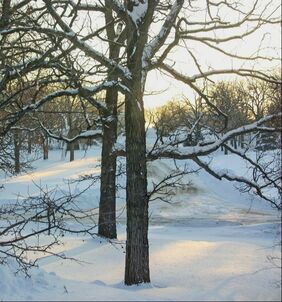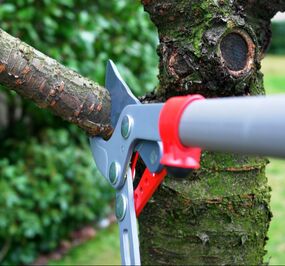 The winter temps are going up and down take their toll on trees. Even for tree types use to cold areas, this is a harrowing time. And this is mainly true for the isolated and exposed trees of the Syracuse homes. Some of this stress is inevitable. Tree owners have no control over the temperature and weather. Though, there are things that you can do to keep your trees healthy through winter. Cold Stress Problem Cold stresses take many forms. The first is the influence on older trees of a swift change between daytime heat and nighttime freezing and daytime heat. These temps changes can bring on stresses in the tree between the interior wood and outer bark, causing cracks called frost cracking. What to do There is very little that can be done to stop frost cracking. In many instances, the tree is capable of repairing itself even though the cracked area stays vulnerable and ensuing cracking at the same place can bring on significant damage. With young trees and tropical trees, the tree owner could wrap the bark. To further stop winter damage and diminish moisture loss, contacting a Syracuse arborist can be very beneficial. Problem Another cold stress is the effect of unexpected early frosts on late growth. Tree growth in the late season is susceptible since it doesn’t have the same time as established growth to get ready for the cold. What to do To avoid this, you shouldn’t prune until after the tree has begun dormancy in the fall. Pruning too soon might urge new growth and raise the risk of frost damage. Also, don’t use fertilizers with large amounts of nitrogen. Trees can benefit from correct fall fertilization. However, you should know what to avoid. Winter Drought Problem At some points in the wintertime, particularly with evergreens, drying out can be a serious issue. Winter drought happens when a tree loses more water than it can take in from the frozen ground. This is particularly accurate during the early spring when the ground stays frozen while the spring sun starts warming every part of the tree. What to do While there is no spot-on solution to winter drought, you can control the issue by putting down a layer of mulch around the tree’s base before winter. The mulch helps to decelerate moisture loss while working as a temp buffer for the roots.  Although we have snow and cold outside, winter is the best time of year to schedule winter tree pruning. Wait for a mild, sunny day, grab your pruners, and take a good look at your trees. Winter Pruning Advice Have a well-defined purpose in mind when you prune a tree. Think about what you want to do to the tree you're pruning. Most deciduous pruning tasks must promote a natural style, meaning that tall trees are not topped or cut to make them shorter, the natural outline of a tree is maintained, and low-limb trees aren’t being trimmed too harshly. The goal is to highlight the tree's natural features. If you do it well, it looks like you didn't do anything at all. Remove undesirable branches. Remove all diseased or dead wood. It doesn’t matter where it is located on the plant. Then, remove all water sprouts and suckers. Remove rubbing or crossing branches. Begin with the biggest limbs and move steadily to the littlest. There may be instances when you break this rule. For instance, leave a large crossing limb that would destroy your tree if removed. Thin out the canopy. Beginning in the middle and traveling to the outside, thin the limbs that make up the dense mass of a tree. Your aim is to improve air circulation in the tree limbs and to put emphasis on the structure of the tree. Never remove over one-quarter of a tree in a season since that encourages sucker growth. Work steadily, taking lots of breaks to take a step back and look. Is the tree even? Know when to end. You don't want to hollow out the middle. You can go back and take more off. Prune back to a branch. Never leave an open end that comes from topping a tree. Open ends can make dense horizontal growth that wrecks the natural branching pattern, or they can cause disease and death. Look for insect problems. The eggs of gypsy moths, tussock moths, and tent caterpillars are frequently visible on tree branches in winter. Remove them by hand or prune to control insect damage in the spring. If you need assistance, hire a tree contractor.  Older trees are just like older human beings. Those that have positively overcome challenges and get to maturity enjoy some unique advantages that come with being very grown up. Both also need some extra attention and love to stay healthy and enjoy an honorable old age. When it comes to longevity, trees have an edge over humans. Some, usually hardwood types like beech, oak, and maple, live up to 300 years. They are a gift from our ancestors to our children and coming generations. A healthy tree rises in value as it gets old. Our Syracuse community enjoys the bonuses, such as enhanced air quality, improved property values, modern temps, energy savings, wildlife habitat, moderate temps, and stormwater control. We are still discovering all the ways our older trees protect us. As the foundation of our community, our older trees warrant our care and respect as they pass their prime. Having grown as wide and tall as their species says, these mature trees unavoidably start to deteriorate. It has been stated that trees, like humans, have a middle age spread. As they mature, tree growth dwindles since they can’t store energy. They make fewer leaves, so they aren’t as effective at photosynthesis. They are less accepting of stress, either man-made stress such as compacted soil, pesticide use, and mower damage or environmental stress like insects, disease, or drought. If you are wondering how to care for older trees, regular preventative maintenance will guarantee that they live a happy, long life with dignity. Mature Tree Tips Routine Inspection: We don’t think twice about the importance of yearly checkups for our families and ourselves. Likewise, routine checkups for your trees by a Syracuse arborist every year or two is crucial, the arborist will recommend pruning when it's needed to keep the tree healthy. They encourage positive tree health by detecting minor issues before they get serious. Arborists are trained to look for illnesses such as discolored leaves, rotting bark, or reduced growth. If you sense any of these things on your trees, don’t wait for a checkup! Call an arborist ASAP. Correct Mulching: A layer of mulch offers numerous benefits, particularly to mature and young trees. Mulch aids trees to retard soil erosion, discourage weeds, stop soil compaction, and retain moisture. Modifying the height of your mower is typically a straightforward procedure. Contemporary lawn mowers are easy enough that you can see at a glance precisely how to make the changes. Though, some are not so easy. Sometimes it isn’t a matter of complexity, but knowing what height is correct for your yard.
For setting your mower at the correct height, adhere to these recommendations. Step 1 – Owner’s Manual It doesn’t matter what mower type you have, the first thing you must do is look and see what the owner’s manual says about setting the height of your mower. Even on the basis of designs, adjustments vary from brand to brand. Also if the right way to adjust it seems obvious, there might be something you’re missing, and you won’t realize it until you’ve taken a look at the manual. Step 2 – Set it on Flat Surface To indeed see how low or high your mower is, put it on a flat surface like a patio or driveway before doing any adjustments. Also, if you're working with tools, like a wrench, you’ll be less likely to lose it on the concrete than in your lawn. Step 3 – Gauge When you don’t know how high your mower should be, always begin at the top and work your way down. Though, to get a more accurate cut without the trial and error, you can roughly gauge how tall is your grass. Next, measure from the side your mower is on up to the fan blades. Step 4 – Making Changes Consistently make sure that your mower has little chance of coming on before you make changes. For most mowers, there’s a safety catch that has to be held down in order for it to run. So, make sure it’s not being pressed on by anything. For more security, you can always take out the spark plug while making changes. You can alter most modern mowers by just moving a lever. Some may need you to adjust every wheel one at a time. If this is the case, make sure you don’t change them to various heights by accident. Get in touch with a professional tree care company if you need more help. |
AuthorWe at Syracuse Tree Service want to help you with your tree service needs, our blog is where we provide helpful tips and ideas for the health of your trees. Archives
December 2020
Categories
All
|
- Home
- Services
- About
- Contact
-
Service Locations
- Liverpool Tree Service
- North Syracuse Tree Service
- Cicero Tree Service
- Baldwinsville Tree Service
- Manlius Tree Service
- Weedsport Tree Service
- Clay Tree Service
- Bridgeport Tree Service
- Lafayette Tree Service
- Fayetteville Tree Service
- Chittenango Tree Service
- Camillus Tree Service
- Onondaga Tree Service
- East Syracuse Tree Service
- Blog
|
Home | Services | About Us | Contact Us
Liverpool | North Syracuse | Cicero | Baldwinsville | Manilus | Weedsport | Clay | Bridgeport | Lafayette | Fayetteville | Chittenango | Camillus | Onondaga | East Syracuse © Syracuse Tree Care 2017
Syracuse Tree Care 4736 Onondaga Blvd Suite 112 Syracuse, NY 13219 (315) 692-0186 |
|


 RSS Feed
RSS Feed